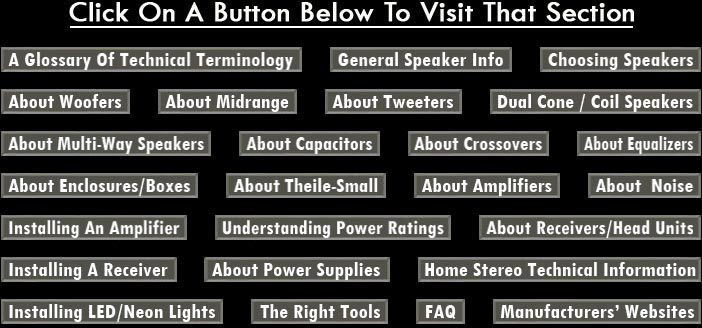


What tools should I have in order to do a good installation?
Multiple size screwdrivers, both flathead and Phillips.
Phillips screws are most common; be sure to have #0, 1, and 2 sizes. Magnetic screwdrivers are especially useful when trying to get screws into (and out of) tight places.
Soldering Iron
Makes the best connections if done with care. Use 60/40 rosin core electrical solder. The soldering tool should use power of between 50 to 75 watts for most purposes
Electrical tape
Use quality tape that has long lasting adhesion at extreme temperatures.
Wire cutters/strippers and crimpers
For stripping insulation easily, use a pair with stripper holes precut for common wire sizes and a smaller clipper for finer wire.
Angled screwdrivers
Often makes removing dash and rear deck speakers a lot easier, when windows limit maneuvering space.
Various wrenches, pliers, and socket sets
The specific types and sizes you need will depend on your vehicle.
Multimeter (VOM)
Essential to diagnose and understand installation problems.
Metal drill and saw
You'll need these if you need to modify your vehicle for new
speaker cutouts or to accommodate a new head unit.
Hot glue gun
Good for installing carpeting or putting door panel trim back in place after modifications.
Razor knife
Helps for cutting carpet and keeping cut out holes neat on door panels or interior walls, especially when installing speakers.
Hammer
For working out frustrations and occasionally delivering needed force to start holes for screws etc.
Flex tubing & shrink wrap insulation
Good for protecting wire and insulating connections, especially in the engine compartment.
Extra hardware
Nuts, bolts, screws, crimp-on connectors, wire rolls, tie-downs, etc.
Fuse puller and extra fuses
In addition to the fuses for your system, check your car's
fusebox to find the various sizes you'll need. Also, while you can use needle-nosed pliers to pull fuses, always disconnect the battery before doing so.
Wire ties
Keeps the wiring neat and secure
Small light source
A flashlight or other light source will let you know what surprises linger in the dark spots.
Tape measure
Keep your wires as long as necessary, and as short as possible.














